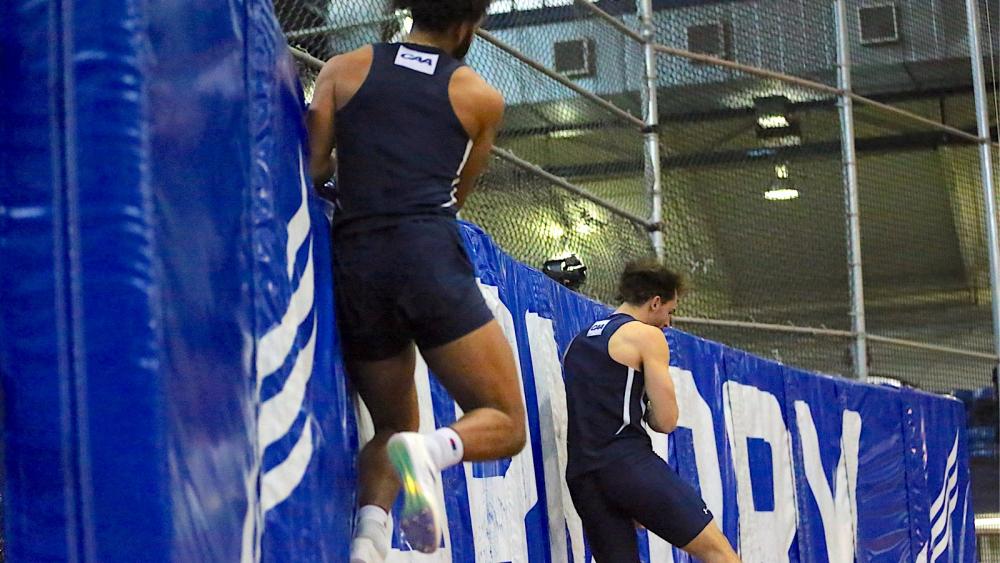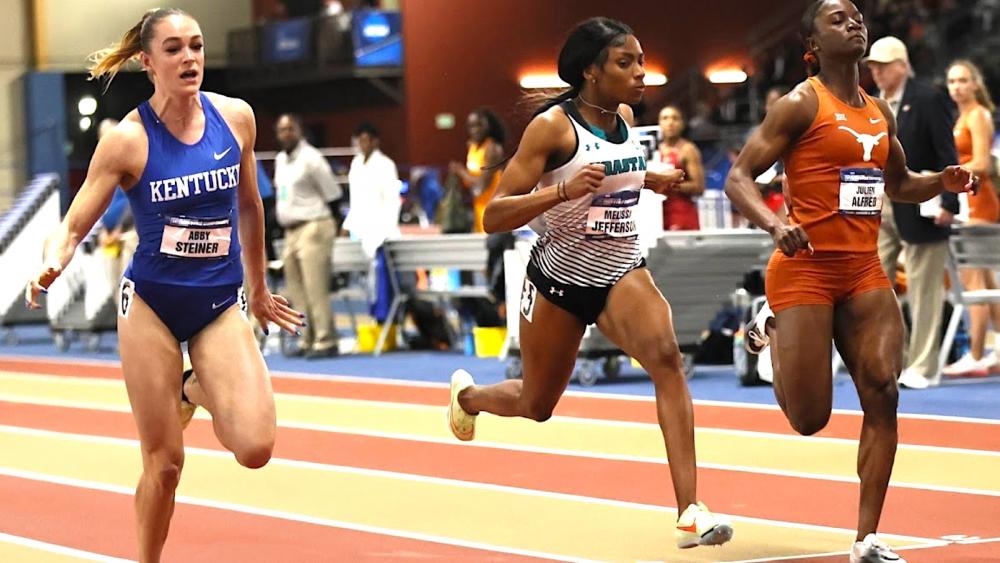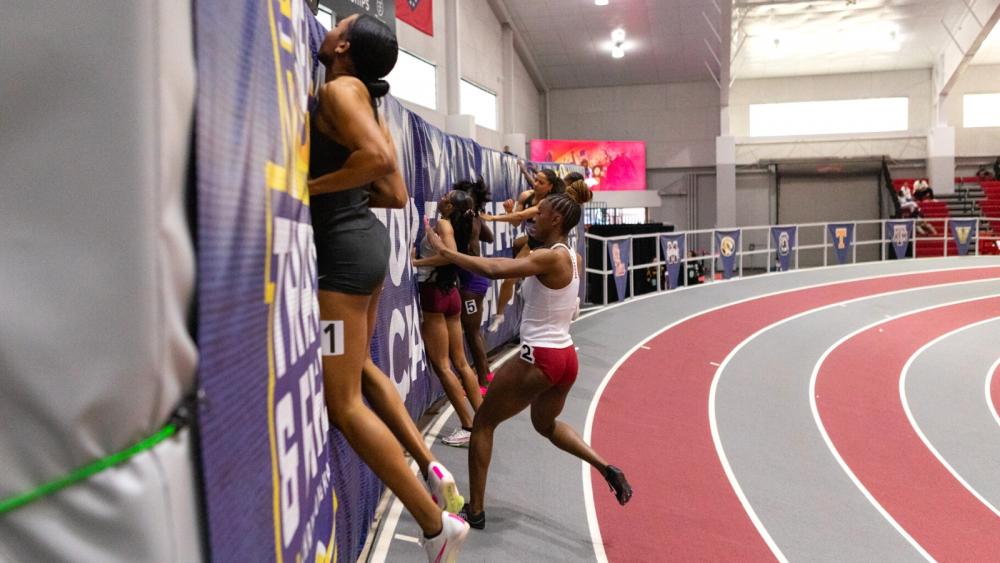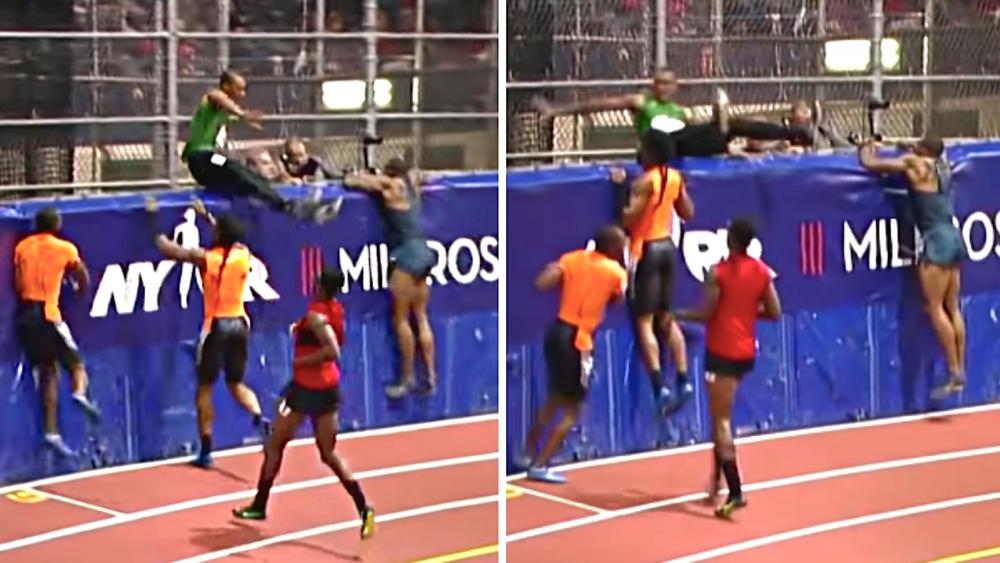Folders |
Crash Pad: A Deep Dive Into An Essential, But Overlooked, Element Of Indoor TrackPublished by
Full Speed Into The Crash PadA DyeStat story by Dave Devine Lead photo by Crash Kamon __________ It might be the most electric, explosive track event in all of athletics. The shortest sprint with the thinnest margin of error. Sixty unforgiving meters, covered in six-and-a-half seconds. Victory, for the most elite, demanding an effort that borders on perfection. At the highest level, no room for miscalculation. And this is certainly the highest level: The 2024 USATF Indoor Championships in Albuquerque, New Mexico. On the line for the men’s 60-meter dash final: a collection of World and Olympic medalists highlighted by one of the marquee matchups of the entire championship: Christian Coleman and Noah Lyles, two sprinters with contrasting styles, shoulder-to-shoulder in lanes 4 and 5. The crib sheet oversimplification would suggest that Coleman is a fast starter and Lyles is a fast finisher, but that framing belies the ways in which professional sprinting has become as much about science as it is about athleticism. No stone has been left unturned in the preparation for this moment. Every aspect of the race — analyzed and documented. Joint angles and arm drive. Acceleration and drive phase. Stride length and stride frequency and force application. From the shakeout at the blocks to the lean at the line — all covered. Gun to tape. And at that gun, as expected, Coleman is out blindingly fast. But Lyles devours the second half of the race and dips past his rival in the final stride. It’s a riveting showdown that delivers in spades — 6.43 world lead for Lyles, Coleman at 6.44 — but it’s not quite over. Lyles can’t celebrate just yet. Unlike the 100-meter dash, with its sweeping outdoor curve that offers sufficient space for braking, this is a 200-meter banked indoor track, with all the restrictions that oval imposes. And so, in a mad flurry, all eight men flicker up the track’s banked curve and hammer into the thick padding installed at the top. Lyles spins right and slams his upper back into the mat. Coleman half-turns, raises a leg, and buries his left shoulder into the foam. The next lane over, Ronnie Baker scales the pads in stride. In lane 1, Brandon Carnes leads with his chest and ricochets backwards. It all seems arbitrary and chaotic. But for an event in which every meter is considered, in which consistent practice provides the blueprint for perfect execution, surely there’s a plan here, too. It can’t possibly be the case that these finely tuned athletes, sprinters with careers that depend on remaining injury-free, are left, at the end of a 60-meter race, intuiting their way through this sudden, jarring terminal event. In other words, they practice this thing — right? “Nope, we sure don’t,” says Carnes, fifth in that national 60-meter final. “I’ve never really thought about it, but we do not practice hitting the pads — at all.”
It’s something that might be easily overlooked. A safety measure, like so many others in the world of athletics, born of necessity. An 8-foot high, vinyl-wrapped wall of foam that receives, at most, a few moments of screen time on a televised track and field meet. Otherwise, it fades into the background, a facility-branded afterthought. The indoor crash pad. Given the role it plays in the highest profile 60-meter sprint and hurdle races on the undercover circuit, and the dramatic, frenzied way athletes plow into its folds, it’s understandable that there might be some questions. How, for instance, is it manufactured? Is there a standard to which all crash pads must adhere? And how, exactly, do they cushion a sprinter decelerating from speeds north of 20 miles-per-hour in such a short time frame? Mike Cunningham is one person who has at least some of the answers. Currently the national business development manager for Gill Athletics, and the host of the popular Gill Connections podcast, Cunningham spent a decade coaching collegiate sprinters and hurdlers, most recently at Mississippi State University. If there’s anyone who’s considered crash pads from both sides, it’s him. “It’s funny,” Cunningham says, “you think about things differently when you’re on the manufacturing side versus the coaching side, but I never thought about those pads when I coached. Ever. It was just like, Yeah, just use them to stop. You’ll figure it out.” Now, it’s among the things he thinks about all the time. Gill Athletics, he says, does not carry a standard, one-size-fits-all crash pad in their inventory of track and field equipment. Each is engineered and customized for the facility in which it’s installed. One of the challenges, Cunningham allows, is that no universal safety standard exists for track and field crash pads, so for every one Gill produces, the company adheres to an “ASTM standard” developed for gymnasium wall padding (which Gill also produces). ASTM, formerly the American Society for Testing and Materials, is an international organization providing “voluntary consensus technical standards” for a wide variety of products, materials and services. Their ASTM Standard F2440-11 includes minimum acceptable measures for wall padding shock absorption using two criteria: Gmax (the ratio of maximum negative acceleration on impact in units of gravity to the acceleration due to gravity) and HIC (Head Injury Criterion, or the likelihood of a head injury arising from an impact). All of Gill’s crash pads, Cunningham says, meet that ASTM standard. From there, things get trickier. “Unfortunately,” he says, “there’s no set standard of — you need a crash pad, so it’s this thick, and this wide and tall. No one’s ever actually created that. And therefore, you see a lot of different set-ups all around the country.” He rattles off an assortment of indoor tracks from coast to coast, collegiate to privately managed. Fixed-bank, flat, hydraulic. Each oval with its own nuances and defining characteristics. “I think that’s probably why there’s been no standard through an agency like ASTM,” he says. “Unlike wall padding, where we know what the basketball court dimensions are going to look like, an indoor track facility is allowed to be built 100 different ways.” While the facilities might differ, the basic padding construction is the same. The outer layer is comprised of vinyl, essentially the same material Gill uses on the sides of high jump and pole vault landing pits. The inside material is bonded foam, engineered to strike a balance between compression and density. Cunningham compares it to their pole vault padding: elite athletes would love for the foam to be exceptionally forgiving, since they’re falling into it from 20 feet in the air, but if the foam is too soft, the vaulter will bottom out in the pit. The same is true, he says, for a sprinter pushing far enough into the crash pad to hit the wall or support structure on the far side. “It’s a real balancing act on how soft or how firm, so it’s safe but not hurting you.” Which brings him back to his coaching days. When he thinks about it now, Cunningham still can’t quite believe he and his colleagues never coached their athletes on how to hit the pads. “We planned for everything,” he says, “except for that one spot. It’s kind of odd, actually. If you ask any sprinter, I imagine most of them tell you they don’t have a plan. They don’t even think about it — until they’re five meters from it.”
Ronnie Baker, third in that USATF 60-meter final behind Lyles and Coleman, certainly knows his way around track’s shortest dash. His 6.40 personal best ranks him third all-time in the event. He was twice an NCAA champion at the distance, and claimed 60-meter bronze at the 2018 IAAF (now World Athletics) Indoor Championships. Asked about his preparation for the fleeting, two-second window between crossing the line and colliding with the pads, he’s somewhat cavalier in his response. “Yeah, we don’t necessarily work on running into the crash pads,” Baker says. “You just do it.” His preferred technique, when he thinks about it, is to step into the pad and scale it. But he’s seen all kinds of maneuvers: shoulder crash, side smash, chest bump, Spiderman, reverse spin, fetal position, spikes-up and high fives. Brandon Carnes, the USATF fifth placer, has seen all of it, too, and acknowledges that almost every athlete takes a different tack. “It all comes down to how you’re accelerating when you cross the finish line,” Carnes says, “It’s different for everybody.” Melissa Jefferson, the 2022 NCAA 60-meter champion indoors for Coastal Carolina, hasn’t competed this winter as she acclimates to a new Florida training group, but she echoes Carnes when it comes to the variety of approaches — and finds the lack of predictability unsettling. “It’s always been something that I feel is very risky,” she says, “just because everybody does it different.” In her case, she’s never been particularly adept at rapid deceleration. “I’ve seen it happen that people get hurt,” she says, “trying to slow down so quickly after being at their top-end speed. And for me, I’ve learned to slow down as fast as a can, but not kill myself in doing it.” She finds the crash pad a mixed blessing, depending on her body’s positioning when she hits it. Asked whether she intentionally slows before reaching the pads, or allows them to fully absorb her momentum, she says it’s a little of both. “I try to slow before I hit the pads,” she says, “but also, if I’m really moving, I’ll almost run up the pad.” That was certainly true at the 2022 NCAA indoor champs, when Jefferson soared to victory over Kentucky’s Abby Steiner, and was then left improvising her collision in real time. She kicked her foot instinctively, planted her hands and elevated up the pad. “That was the only thing I could think to do in the moment,” she says. “It’s based off adrenaline. How fast your body can come down off that adrenaline, and what’s the next best thing for me to do?” According to Carnes, the same improvisation plays out when the race doesn’t go to plan. On a disappointing finish, he says, you’ll see sprinters and hurdlers come to a near-stop before reaching the pads. How you hit pad is a function of how well the race went. “When you don’t execute the race,” he says, “you’re not going to accelerate through the finish like you should.” In the end, though — as Cunningham from Gill Athletics noted — the crash pad experience is affected as much by the facility as it is the padding. “It really depends,” Jefferson says, “on which track you’re running on.”
When it comes to track layouts, Tim Fulton and Paul Christiansen know something about the minutiae of indoor ovals. Fulton is the track and field consultant and meet director at The Armory track in Washington Heights, New York. He’s wrapping up his twenty-fourth season at the venerable, 110-year-old institution. Christiansen is director of sports for the Spokane Public Facilities District, which includes the sparkling new Podium indoor track in the heart of downtown Spokane. He was involved in the research, design, and now daily operations for the 3-year-old building. Separated by more than 2,500 miles, the two ovals are even farther apart when it comes to history and engineering. The Armory, long regarded as one of the fastest indoor tracks in the United States, is the site of the annual Millrose Games and myriad other high-profile meets. It’s a fixed-bank, 200-meter track on the third floor of a century-old building. The Podium is a hydraulically banked 200-meter oval that can be lowered for straightaway races. It’s the only track of its kind on the West Coast, and it opened in September 2021. While the Podium is still developing its calendar of meets, the Armory stages a dizzying array of competitions every week. For many of those meets, Fulton points out, robust entry lists and rigid time constraints mean that two track events must be contested at once: longer races on the oval, sprints and hurdles on the infield — simultaneously. “At most of our big meets this season,” Fulton says, “we’ve had anywhere from 600 to 700 boys in the 55-meter dash. So, we put up high jump mats at the end of the straights to try to stop them before they get to the track.” Which means that at busy high school invitationals, 60-meter runners never reach the crash pads. And even when they do — in big national invitationals, college meets and pro events like Millrose — the Armory’s unique layout, with its tighter curve radius and longer straights, means there’s sufficient space to hit the brakes. “If you look where the finish line is on our track, it’s back pretty far from the pads,” Fulton says. “There’s room to slow down.” When runners do hit the Armory’s pads at full speed, Fulton is convinced it’s as much about spectacle as it is about stopping. He’s seen plenty of flashy chest-bumps and shoulder slams into the pads. Or spiked foot plants, followed by a quick scramble up the face — which, for the guy overseeing the facility, can drive him crazy. “You can see it in the videos,” Fulton says, “the bottom of those mats gets chewed up pretty good.” It’s one of the things that Christiansen, who worked with a team for years to research and design The Podium, hadn’t anticipated. Originally from a volleyball background, Christiansen became involved with planning when the facility was conceived as a large, multi-court complex to accommodate tournaments. Over time, and on the heels of a fact-finding road trip to indoor tracks in the Midwest and East Coast, the plan morphed into a track and field facility with a hydraulic oval that could be lowered and covered with court flooring. When the Podium staged its first meet, Christiansen looked at the generous, 20-meter gap between finish line and crash pad and wondered if the padding was even necessary. A few rounds of finals on the straight shifted his thinking. “I saw how fast these guys are coming off that finish line after running 60 (meters), and realized they need the crash pad.” But like Fulton, he also saw the lower half of his pricey vinyl mats being shredded by athletes scaling the wall. “We had to put a stop to that quickly,” he says. Now, the Podium’s meet officials remind athletes in the tunnel and on the starting line to keep their feet off the pads. But even with that restriction, Christiansen believes that the oval’s layout, paired with the ability to flatten the bank for straightaway races, creates a safer deceleration for athletes. “I’m not going to say we put a lot of thought into having the longest run-out we could,” he says, “it just kind of ended up that way. But obviously, having the hydraulic track with the ability to lower it helps that run-out tremendously.” For elite sprinters like Ronnie Baker, the longer and flatter the run-out, the better. “I do prefer the tracks that can be lowered,” Baker says, “where we don’t have to run up a bank and then into the pad. Running straight into a pad is a lot safer. Otherwise, you’re flying full speed up a hill into a wall — it’s pretty difficult.”
At this point, it might be helpful to understand the forces at play when a 170-pound sprinter, traveling at 22 mph, plows into a 6-inch piece of foam. Shannon Mayer, Ph.D., chair of the Physics department at the University of Portland, can shed some light on that topic. A UP faculty member for 22 years, Mayer was a collegiate athlete on the track and cross country teams at Pacific Lutheran University in Tacoma, Wash. Her two daughters were on the track team at Portland’s Jesuit High School, as a pole vaulter and a sprinter/hurdler. Which is to say, Dr. Mayer knows the sport. But more importantly, she knows her physics. And she’s more than happy to discuss this phenomenon, unique to indoor track, in which elite athletes reach top speed over a short distance, and then need to come to an abrupt and sudden stop. There are two ways, Mayer says, to describe what’s happening in that moment: either focusing on how much energy the athlete carries into the pads, or how much momentum they are carrying. Momentum, which is the more commonly-heard term in sports, can be defined as “mass in motion.” And since all objects have mass, if an object — or a runner — is moving, then that object has momentum. The amount of momentum an object carries depends upon the mass of the object and the speed, or velocity, at which that mass is moving. She draws a simple diagram of a runner and a wall, and then writes out the equation: Momentum (p) = mass (m) x velocity (v) Mass, she says, is expressed in kilograms, not pounds, while velocity is expressed in meters per second — a unit of measure top sprinters and coaches use all the time. “The way the crash pad works,” Mayer says, “is that you need to stop this person’s forward momentum, and do it in a way that minimizes either the distance that they have to slow down, or the damage to the person.” The force on a sprinter’s body, she points out, is always experienced as a function of time. If they were crashing into a solid wall, because of the sudden halt, they would experience a large force over a very short period of time — an immediate stop. “It’s instantaneous,” Mayer says. “The benefit of the crash pad is that it takes that same change in momentum, and it spreads it out over a longer period of time.” She draws a graph with two curves: 1) short period of time, high peak force, and 2) longer period of time, lower peak force. The area under the two curves is the same, but when the athlete is absorbed gradually into a foam pad, they experience a much lower force on the body. Mayer compares it to a bad car accident, with and without seat belts or air bags. “By stretching out the time period, you really reduce the maximum force, which is the thing that’s going to hurt you.” And this is important: the difference in length of collision might be incrementally small —the difference between colliding with a solid wall and sliding into a crash pad for less than a second — and it still significantly impacts the force sustained. “Even if you’re slowing it down from a millisecond to a tenth of a second,” Mayer says, “that factor of 10 or factor of 100 drops the peak force by that same factor.” She notes one other complicating factor, from a physics perspective. The athletes have already begun decelerating after the finish line, using the friction between their spikes and the track surface to slow their momentum to the pads. “If you had a sheet of ice between the finish line and the crash pad,” she says, evoking something of a nightmare scenario for sprinters and hurdlers, “then they’d continue at whatever their speed was until they hit the pad at that same speed. But they’re busy slowing themselves down. The crash pad takes care of the remaining energy — or it should, if they hit it right.”
Whenever the topic of crash pad mishaps is raised, one incident inevitably comes to mind. The 2015 Millrose Games men’s 60-meter hurdles, when decathlete Ashton Eaton scaled the Armory crash pad, spun at the top, and tumbled headlong into the gap between the pad and the throwing cage. “That was definitely the most memorable crash pad episode we’ve had,” says Fulton, the Armory meet director. “Luckily, it was a guy who was so athletic that he could just go over and not injure himself.” In fact, to the audible relief of the sellout crowd, Eaton emerged from behind the pad with a sheepish smile and no signs of injury. “I mean, it’s really the only story,” Fulton says. “When Ashton went over, that’s the one story you can tell.” Except that it isn’t. Baker, Carnes and Jefferson all have stories of incidents when an athlete was injured, either crashing into the pad or stumbling in anticipation of that contact. “I’ve seen a couple of people trip up the hill,” Baker says, “and they’re basically right at the pad, so they hit it with their face as they’re falling.” Carnes and Jefferson both recall hurdler Grant Holloway flipping over the top of a crash pad a year or two ago. Baker remembers Christian Coleman slamming awkwardly into a pad. Demek Kemp, too. Jefferson brings up last year’s USATF Indoor Championships, when Aleia Hobbs won the women’s 60-meter dash in an American record 6.94, only to falter on Albuquerque’s banked track and carom into the base of the pad. “She broke a bone in her hand because she ran up the bank and then fell down,” Jefferson says, “just trying to slow down.” And Hobbs wasn’t the only finish line casualty at that 2023 USATF indoor meet. Carnes lost his footing on the incline coming out of lane 1, fell hard to the track and strained the posterior cruciate ligament in his knee. Another time, at a meet in France, he sprinted too vigorously into the pads and sustained a lower-leg injury on the rebound. “Hit it hard,” he says, “and when I came down, I landed on my ankle wrong.” Even Baker, who suggests that crash pad practice would be unnecessary — “The race is from zero to 60” — modified his approach after a shoulder-first mishap left him in pain for several days. “I actually I did it at Texas Tech this year,” he says, “and I kind of like — it just didn’t feel good. I was having some shoulder pain for a day or so, because I bruised it pretty bad. So…don’t do that anymore.” But the most jarring recent example might be from this year’s USATF Indoor Championships, the same national meet in which Lyles and Coleman squared off. Hurdler Tia Jones had tied the world record for the women’s 60 hurdles in the semi-finals, and then roared to a national title in the final — seemingly bound for the World Athletics Indoor Championships in Glasgow, Scotland. But after crossing the line, Jones pancaked flat against the crash pad and bounced off, landing awkwardly and somersaulting down Albuquerque’s banked curve. She came up wincing immediately. And while the nature of Jones’ injury hasn’t been disclosed, her coach, Tonja Buford-Bailey, confirmed to DyeStat’s David Woods that an MRI revealed an injury that kept her from competing at the World indoor champs in Scotland. A brutal outcome, and it’s possible that no amount of practice or crash pad strategizing would have prevented an injury like the one Jones sustained. It’s also likely that the angle of the banked track underfoot bore some responsibility for her landing. But it’s equally possible that as athletes get stronger and faster, and the momentum they carry into the pads increases — mass times velocity — the crash pad might warrant additional consideration. As Jefferson and others have said, it’s rarely, if ever, discussed in training. “There’s never been a conversation about what to do when the pad is right there,” she says, “and you’re going full speed with only—” She pauses, reconsiders, circles back again. “It’s seriously just never talked about.” ### |










 John Nepolitan photo
John Nepolitan photo  Chuck Aragon photo
Chuck Aragon photo  Lily Dozier photo
Lily Dozier photo  Crash Kamon photo
Crash Kamon photo  NBC
NBC